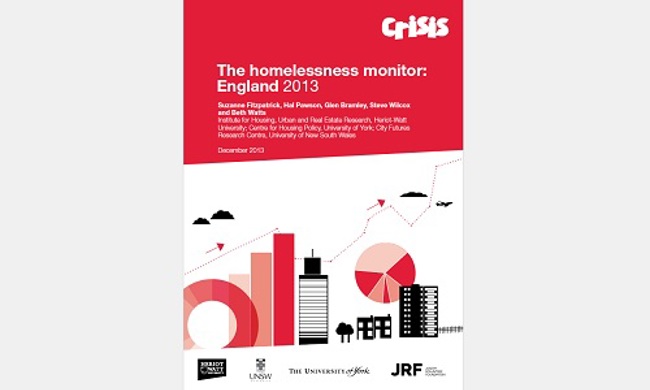The Homelessness Monitor: England 2013
06.04.2013
The Homelessness Monitor: England 2013 is the third annual report of an independent study, funded by Crisis and the Joseph Rowntree Foundation, of the homelessness impacts of recent economic and policy developments in England.
Key findings
- An upward trend has remained evident in ‘visible’ forms of homelessness – including rough sleeping and statutory homelessness – over the past year, but with a slowed rate of increase.
- Thus in 2012 rough sleeping in England rose 6%, as compared with 23% in 2011. In London, there was a rise of 13% in recorded rough sleeping in 2012/13, pushing the two year increase to over 60%. There are growing numbers of both UK and overseas nationals sleeping rough in the capital.
- After falling sharply for six years, the number of statutory homelessness acceptances has risen substantially (by 34%) over the past three years, but the increase in 2012/13 (at 6%) is lower than the previous year (14%). There is marked regional divergence, with the growth in statutory homelessness strongly concentrated in London and the South.
- There are sharply rising numbers being made homeless by the loss of private sector tenancies, accounting for 22% of all homelessness acceptances at national level in 2012/13. This is now the single largest cause of statutory homelessness in London.
- Temporary accommodation placements rose 10% during 2012/13, with B&B placements rising even faster (14%). ‘Out of district’ temporary accommodation placements have doubled since 2010. Use of both temporary accommodation and out of district placements remain overwhelmingly concentrated in London.
- ‘Hidden’ forms of homelessness – including concealed, sharing and overcrowded households – are also far more prevalent in London and the South than elsewhere. Census-based measures of overcrowding, for example, suggest a rate of 5% across England (a total of 1.06 million households), but 12% in London. Census overcrowding increased by 23% between 2001 and 2011, with a rise of 35% in Outer London.
- This regional disparities ‘story’, that strengthens with each year of the Monitor, strongly suggests that housing system factors are playing a critical underlying role. The continuing shortfall in levels of new house building relative to levels of household formation, in a context where there are already substantial numbers of concealed and sharing households, and severe levels of overcrowding in London, is a prime structural contributor to homelessness.
Reference
Fitzpatrick, S., Pawson, H., Bramley, G., Wilcox, S. & Watts, B. (2013) The Homelessness Monitor: England 2013. London: Crisis.

